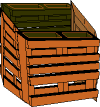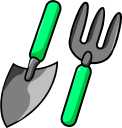MAKE YOUR OWN COMPOST
…for a greener and cleaner earth…
Everyday, households and industries dispose of large amounts of waste, which usually end up in the streets, canals, rivers and other water forms. "Reduce, reuse and recycle" is the basic campaign to help solve this problem. Unfortunately, not many people are determined to pursue these techniques because they see waste reduction as a tiresome and time-consuming chore. Thus, tons of garbage continue to sit on the streets and on every possible empty space there is in the metropolis.
 A traditional but very effective way to reduce waste is readily available for households: composting. With composting, most biodegradable materials are decomposed into a dark, earthy, powdery substance called compost. Organic materials such as food scraps, leaves and yard wastes, paper products, and wood are broken down by various microorganisms into simpler substances with the use of oxygen. Compost then serves as fertilizer which can help in the growth of plants.
A traditional but very effective way to reduce waste is readily available for households: composting. With composting, most biodegradable materials are decomposed into a dark, earthy, powdery substance called compost. Organic materials such as food scraps, leaves and yard wastes, paper products, and wood are broken down by various microorganisms into simpler substances with the use of oxygen. Compost then serves as fertilizer which can help in the growth of plants.
Composting does not only reduce garbage around the house, it is equally beneficial for the environment. It increases the nutrients in the soil, encourages earthworms to dig up soil, holds water, helps control disease, and improves overall drainage to reduce soil erosion.
Making your own compost is easy! All you need is to follow these simple steps.
Materials needed:
- a place to put materials to be composted: compost bin or compost pit
Compost bin -- this is a ready-made large container made out of wood, aluminum, chicken wire lined with cardboard or any hard
material. You can either make one or buy one from any hardware store.

Compost pit -- this is a hole about 1 x 1 m and 60 cm deep dug in an open space in your backyard or in any open lot
- household wastes - be sure to chop these materials into small pieces
"browns": dried leaves and grass, sawdust, twigs, paper, wood shavings, some soil
"greens": vegetable and fruit peelings, egg shells, tea bags, food scraps like small pieces of meat and fish bones, coffee grounds
- garden fork or shovel

- plastic or any canvas sheet to cover compost
- small amount of water
- hand gloves (optional)

To do it:
- Choose a place in your backyard which gets good sunlight especially in the morning, but is shaded from midday through afternoon to ensure moisture in the pile. This is where you should situate your compost bin or pit. After positioning your compost bin or making your compost pit, you are ready to put in the materials to be composted.
- Start with a layer of coarse stuff like small branches, dried leaves or grass cuttings -- the "browns".



- Add a layer of old compost, rotten manure or seaweed.
- Put in the kitchen wastes -- the "greens".



- Continue putting equal parts of the "browns" and "greens" on top of each other in layers. Don't flatten. Air should pass through layers.
- Dampen with some water.
- Cover with plastic to hasten decomposition. This is will also help keep the compost material inside from being blown by the wind and to discourage flies.
- Turn the compost with a garden fork or shovel every few days to hurry the process along. Better yet, use earthworms. They are the most natural "diggers" of soil, thus they can speed up composting.

- Allow 3 to 6 months to complete the composting process.
- When it is done, it will be a rich, dark humus. Dig it out of your compost bin or pit, spread it on your garden beds, and watch your plants enjoy it!

Just think of all the smelly household trash you can get rid of when you convert this garbage into fertilizer for your plants. So put on those gloves, ready the shovel and find a perfect spot in your backyard. With sure ease and without any cost, you can do your part in cleaning up the environment through composting!
1 | 2 | 3
All rights reserved © 2002
Verlaine June Ramos y Sigue
University of the Philippines - Diliman, Quezon City
email me
 A traditional but very effective way to reduce waste is readily available for households: composting. With composting, most biodegradable materials are decomposed into a dark, earthy, powdery substance called compost. Organic materials such as food scraps, leaves and yard wastes, paper products, and wood are broken down by various microorganisms into simpler substances with the use of oxygen. Compost then serves as fertilizer which can help in the growth of plants.
A traditional but very effective way to reduce waste is readily available for households: composting. With composting, most biodegradable materials are decomposed into a dark, earthy, powdery substance called compost. Organic materials such as food scraps, leaves and yard wastes, paper products, and wood are broken down by various microorganisms into simpler substances with the use of oxygen. Compost then serves as fertilizer which can help in the growth of plants. 









